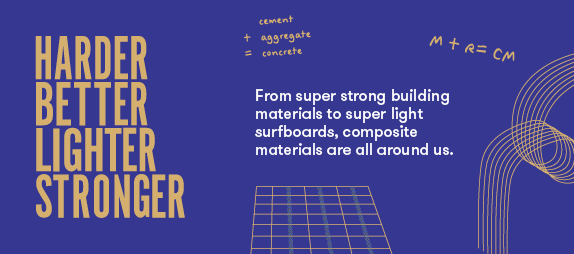The science and technology of composite materials
Expert reviewers
Professor Jim Williams AM FAA FTSE
Research School of Physics and Engineering
The Australian National University
Essentials
- Composite materials are formed by combining two or more materials with different properties, without dissolving or blending them into each other
- Examples include concrete, mud bricks, and fibreglass
- Most composites are made by taking one material (the matrix) and having it surround fibres or fragments of a stronger material (the reinforcement)
- Engineers have many choices during the manufacturing process to determine what the properties of the resulting composite will be
- Modern aviation has been the primary driver for composite materials, as it has great demand for materials that are both light and strong
Listen to this topic
In an advanced society like ours we all depend on composite materials in some aspect of our lives. Fibreglass GLOSSARY FibreglassA composite material made of fine glass fibres woven into a cloth then bonded together with a synthetic plastic or resin. was developed in the late 1940s and was the first modern composite. It's still the most common, making up about 65 per cent of all the composites produced today. It's used for boat hulls, surfboards, sporting goods, swimming pool linings, building panels and car bodies. You may well be using something made of fibreglass without knowing it.

What makes a material a composite
Composite materials are formed by combining two or more materials that have quite different properties. The different materials work together to give the composite unique properties, but within the composite you can easily tell the different materials apart – they do not dissolve or blend into each other.
Composites exist in nature. A piece of wood is a composite, with long fibres of cellulose (a very complex form of starch) held together by a much weaker substance called lignin. Cellulose is also found in cotton and linen, but it is the binding power of the lignin that makes a piece of timber much stronger than a bundle of cotton fibres.
It's not a new idea
Humans have been using composite materials for thousands of years. Take mud bricks for example. If you try to bend a cake of dried mud, it will break easily but it is strong if you try to squash, or compress it. A piece of straw, on the other hand, has a lot of strength when you try to stretch it but almost none when you crumple it up. When you combine mud and straw in a block, the properties of the two materials are also combined and you get a brick that is strong against both squeezing and tearing or bending. Put more technically, it has both good compressive strength GLOSSARY compressive strengthThe maximum stress that a material will bear when it is subjected to a load that pushes it together. and good tensile strength GLOSSARY tensile strengthThe maximum stress a material will bear when it is subjected to a stretching load. .
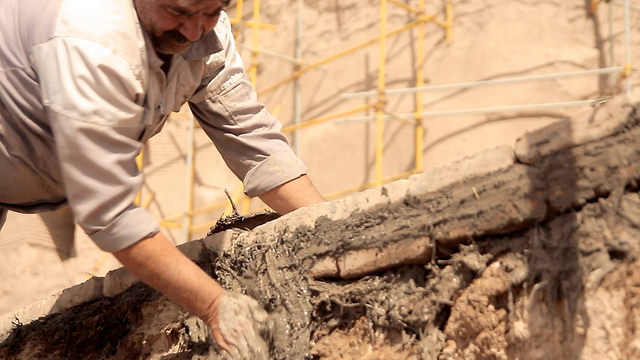
Another well-known composite is concrete. Here aggregate (small stones or gravel) is bound together by cement. Concrete has good strength under compression, and it can be made stronger under tension by adding metal rods, wires, mesh or cables to the composite (so creating reinforced concrete).
Composites have been made from a form of carbon called graphene combined with the metal copper, producing a material 500 times stronger than copper on its own. Similarly, a composite of graphene and nickel has a strength greater than 180 times of nickel.
As for fibreglass, it’s made from plastic GLOSSARY plasticSolid material consisting of organic polymers. that has been reinforced by filaments or fibres of glass. These filaments can either be bundled together, and woven into a mat, or they are sometimes cut up into short lengths which are randomly oriented in the plastic matrix.
More than strength
Nowadays many composites are made for functions other than simply improved strength or other mechanical properties. Many composites are tailored to be good conductors or insulators of heat or to have certain magnetic properties; properties that are very specific and specialised but also very important and useful. These composites are used in a huge range of electrical devices, including transistors, solar cells, sensors, detectors, diodes and lasers as well as to make anti-corrosive and anti-static surface coatings.
Composites made from metal oxides can also have specific electrical properties and are used to manufacture silicon chips that can be smaller and packed more densely into a computer. This improves the computer’s memory capacity and speed. Oxide composites are also used to create high temperature superconducting properties that are now used in electrical cables.
Making a composite
Most composites are made up of just two materials. One material (the matrix or binder) surrounds and binds together a cluster of fibres or fragments of a much stronger material (the reinforcement). In the case of mud bricks, the two roles are taken by the mud and the straw; in concrete, by the cement and the aggregate; in a piece of wood, by the cellulose and the lignin. In fibreglass, the reinforcement is provided by fine threads or fibres of glass, often woven into a sort of cloth, and the matrix is a plastic.
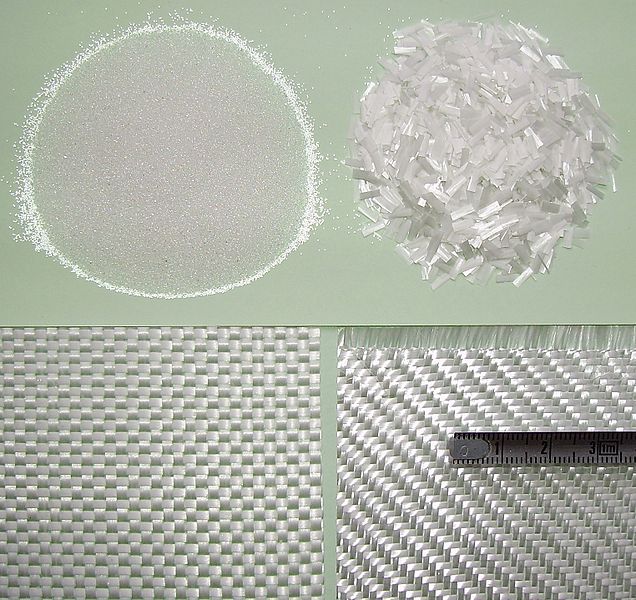
The threads of glass in fibreglass are very strong under tension but they are also brittle and will snap if bent sharply. The matrix not only holds the fibres together, it also protects them from damage by sharing any stress GLOSSARY stressForce per unit area. It is measured in the same units as pressure, namely pascals (Pa). Materials typically have strengths in the megapascal (MPa) range (1 MPa = 1,000,000 Pa). among them. The matrix is soft enough to be shaped with tools, and can be softened by suitable solvents to allow repairs to be made. Any deformation of a sheet of fibreglass necessarily stretches some of the glass fibres, and they are able to resist this, so even a thin sheet is very strong. It is also quite light, which is an advantage in many applications.
Over recent decades many new composites have been developed, some with very valuable properties. By carefully choosing the reinforcement, the matrix, and the manufacturing process that brings them together, engineers can tailor the properties to meet specific requirements. They can, for example, make the composite sheet very strong in one direction by aligning the fibres that way, but weaker in another direction where strength is not so important. They can also select properties such as resistance to heat, chemicals, and weathering by choosing an appropriate matrix material.
Choosing materials for the matrix
For the matrix, many modern composites use thermosetting or thermosoftening plastics (also called resins). (The use of plastics in the matrix explains the name 'reinforced plastics' commonly given to composites). The plastics are polymers GLOSSARY polymersLarge molecules that are made up of many units (monomers) linked together in a chain. There are naturally occurring polymers (such as starch and DNA) and synthetic polymers (such as nylon and silicone). that hold the reinforcement together and help to determine the physical properties of the end product.
Thermosetting plastics are liquid when prepared but harden and become rigid (ie, they cure) when they are heated. The setting process is irreversible, so that these materials do not become soft under high temperatures. These plastics also resist wear and attack by chemicals making them very durable, even when exposed to extreme environments.
Thermosoftening plastics, as the name implies, are hard at low temperatures but soften when they are heated. Although they are less commonly used than thermosetting plastics they do have some advantages, such as greater fracture toughness, long shelf life of the raw material, capacity for recycling and a cleaner, safer workplace because organic solvents are not needed for the hardening process.
Ceramics, carbon and metals are used as the matrix for some highly specialised purposes. For example, ceramics are used when the material is going to be exposed to high temperatures (such as heat exchangers) and carbon is used for products that are exposed to friction and wear (such as bearings and gears).
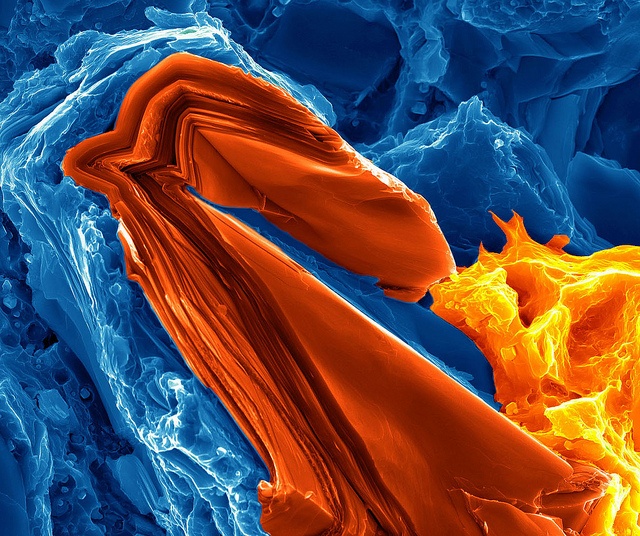
Choosing materials for the reinforcement
Although glass fibres are by far the most common reinforcement, many advanced composites now use fine fibres of pure carbon. There are two main types of carbon that can be used – graphite and carbon nanotubes. These are both pure carbon, but the carbon atoms are arranged in different crystal configurations. Graphite is a very soft substance (used in ‘lead’pencils) and is made of sheets of carbon atoms arranged in hexagons. The bonds holding the hexagons together are very strong, but the bonds holding the sheets of hexagons together are quite weak, which is what makes graphite soft. Carbon nanotubes are made by taking a single sheet of graphite (known as graphene) and rolling it into a tube. This produces an extremely strong structure. It’s also possible to have tubes made of multiple cylinders – tubes within tubes.
Carbon fibre composites are light and much stronger than glass fibres, but are also more expensive. Of the two, graphite fibres are cheaper and easier to produce than carbon nanotubes. They are used in aircraft structures and in high performance sporting equipment like golf clubs, tennis rackets and rowing boats, and are increasingly being used instead of metals to repair or replace damaged bones.
Even stronger (and more costly) than carbon fibres are threads of boron. Nanotubes of boron nitride have the additional advantage of being much more resistant to heat than carbon fibres. They also possess piezoelectric qualities, which means they can generate electricity when physical pressure is applied to them, such as twisting or stretching.
Polymers can also be used as the reinforcement material in composites. For example, Kevlar, originally developed to replace steel in radial tyres but best known for its use in bullet-proof vests and helmets, is a polymer fibre that is immensely strong and adds toughness to a composite. It is used as the reinforcement in composite products that require lightweight and reliable construction (eg, structural body parts of an aircraft). Even stronger than Kevlar is a substance made from a combination of graphene and carbon nanotubes.
Choosing the manufacturing process
Making an object from a composite material usually involves some form of mould. The reinforcing material is first placed in the mould and then semi-liquid matrix material is sprayed or pumped in to form the object. Pressure may be applied to force out any air bubbles, and the mould is then heated to make the matrix set solid.
The moulding process is often done by hand, but automatic processing by machines is becoming more common. One of these methods is called pultrusion GLOSSARY pultrusionA continuous moulding process that mechanically aligns long strands of reinforcements for a composite material then passes them through a bath of thermosetting resin. The coated strands are then assembled by a mechanical guide before the curing process. (a term derived from the words 'pull' and 'extrusion'). This process is ideal for manufacturing products that are straight and have a constant cross section, such as bridge beams.
In many thin structures with complex shapes, such as curved panels, the composite structure is built up by applying sheets of woven fibre reinforcement, saturated with the plastic matrix material, over an appropriately shaped base mould. When the panel has been built to an appropriate thickness, the matrix material is then cured.
Sandwich composites
Many new types of composites are not made by the matrix and reinforcement method but by laying down multiple layers of material. The structure of many composites (such as those used in the wing and body panels of aircraft), consists of a honeycomb of plastic sandwiched between two skins of carbon-fibre reinforced composite material.
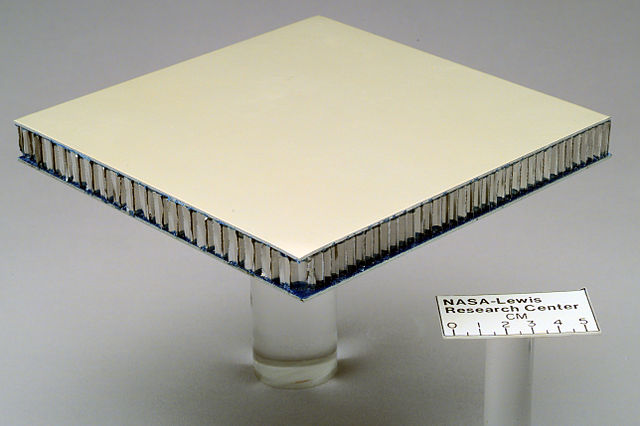
These sandwich composites combine high strength, and particularly bending stiffness, with low weight. Other methods involve simply laying down several alternating layers of different substances (for example, graphene and metal) to make the composite.
Why use composites?
The greatest advantage of composite materials is strength and stiffness combined with lightness. By choosing an appropriate combination of reinforcement and matrix material, manufacturers can produce properties that exactly fit the requirements for a particular structure for a particular purpose.
Modern aviation, both military and civil, is a prime example. It would be much less efficient without composites. In fact, the demands made by that industry for materials that are both light and strong has been the main force driving the development of composites. It is common now to find wing and tail sections, propellers and rotor blades made from advanced composites, along with much of the internal structure and fittings. The airframes of some smaller aircraft are made entirely from composites, as are the wing, tail and body panels of large commercial aircraft.
In thinking about planes, it is worth remembering that composites are less likely than metals (such as aluminium) to break up completely under stress. A small crack in a piece of metal can spread very rapidly with very serious consequences (especially in the case of aircraft). The fibres in a composite act to block the widening of any small crack and to share the stress around.
The right composites also stand up well to heat and corrosion. This makes them ideal for use in products that are exposed to extreme environments such as boats, chemical-handling equipment and spacecraft. In general, composite materials are very durable.
Another advantage of composite materials is that they provide design flexibility. Composites can be moulded into complex shapes – a great asset when producing something like a surfboard or a boat hull.
Additionally, a lot of work is currently being directed towards development of composite materials made from waste products, such as agricultural waste, building materials or plastic drink containers.
The downside of composites is usually the cost. Although manufacturing processes are often more efficient when composites are used, the raw materials are expensive. Composites will never totally replace traditional materials like steel, but in many cases they are just what we need. And no doubt new uses will be found as the technology evolves. We haven’t yet seen all that composites can do.







